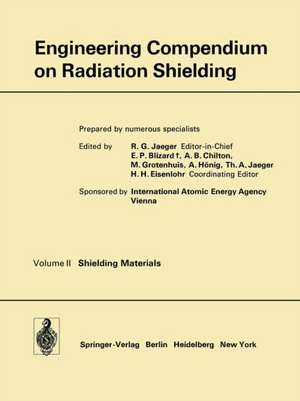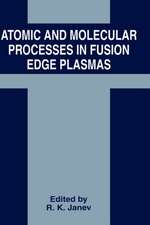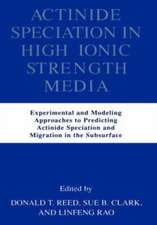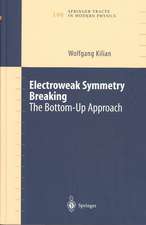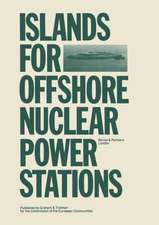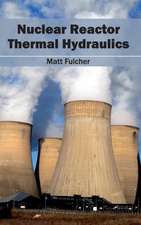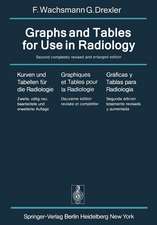Engineering Compendium on Radiation Shielding: Volume 2: Shielding Materials
Editat de R. G. Jaeger, E. P. Blizard, A. B. Chilton, M. Grotenhuis, A. Hönig, T. A. Jaeger, H. H. Eisenlohren Limba Engleză Paperback – 21 dec 2011
Preț: 804.78 lei
Preț vechi: 981.45 lei
-18% Nou
Puncte Express: 1207
Preț estimativ în valută:
153.99€ • 160.78$ • 127.45£
153.99€ • 160.78$ • 127.45£
Carte tipărită la comandă
Livrare economică 04-18 aprilie
Preluare comenzi: 021 569.72.76
Specificații
ISBN-13: 9783642650031
ISBN-10: 3642650031
Pagini: 452
Ilustrații: XII, 436 p.
Dimensiuni: 210 x 280 x 24 mm
Greutate: 1.1 kg
Ediția:Softcover reprint of the original 1st ed. 1975
Editura: Springer Berlin, Heidelberg
Colecția Springer
Locul publicării:Berlin, Heidelberg, Germany
ISBN-10: 3642650031
Pagini: 452
Ilustrații: XII, 436 p.
Dimensiuni: 210 x 280 x 24 mm
Greutate: 1.1 kg
Ediția:Softcover reprint of the original 1st ed. 1975
Editura: Springer Berlin, Heidelberg
Colecția Springer
Locul publicării:Berlin, Heidelberg, Germany
Public țintă
ResearchDescriere
The utilization of nuclear energy makes great demands on the knowledge of the engineers engaged in design work and calculations relating to construction in nuclear industry. Apart, of course, from nuclear reactors themselves, a great deal of nuclear experience is involved in the design and construction of radiotherapy centres, non destructive testing laboratories, particle accelerators, radioisotope laboratories and nuclear research plants. Whereas in the USA there appears to be no great difference in the methods of training personnel for fundamental or for applied science, European universities draw a sharp dividing line between the two fields. However, if we consider graduates solely from the point of view of their activities at their place of employment, two types of personnel can be distinguished: scientifically oriented research workers and those with a more technical and practical background who are looking for rational and rapid methods and solutions, even at some expense in terms of accuracy. The Engineering Compendium on Radiation Shielding endeavours to cover both approaches, the scientific and the technical. Volume I was devoted to the fundamental aspects of shielding, while Volumes II and III discuss its technology.
Cuprins
9 Shielding Materials.- 9.1. Materials against gamma rays.- 9.1.1. Lead and lead alloys.- 9.1.1.1. Introduction.- 9.1.1.2. Occurrence and extraction.- 9.1.1.3. Properties.- 9.1.1.4. Fabrication.- 9.1.1.5. Applications and design considerations.- 9.1.2. Steel (iron and iron alloys).- 9.1.2.1. Introduction.- 9.1.2.2. Occurrence and extraction.- 9.1.2.3. Properties.- 9.1.2.4. Fabrication.- 9.1.2.5. Applications and design considerations.- 9.1.3. Uranium.- 9.1.3.1. Introduction.- 9.1.3.2. Occurrence and extraction.- 9.1.3.3. Properties.- 9.1.3.4. Fabrication.- 9.1.3.5. Applications and design considerations.- 9.1.4. Tungsten.- 9.1.4.1. Introduction.- 9.1.4.2. Occurrence and extraction.- 9.1.4.3. Properties.- 9.1.4.4. Fabrication.- 9.1.4.5. Applications and design considerations.- 9.1.5. Bismuth.- 9.1.5.1. Introduction.- 9.1.5.2. Occurrence and extraction.- 9.1.5.3. Properties.- 9.1.5.4. Fabrication.- 9.1.6. Copper.- 9.1.6.1. Introduction.- 9.1.6.2. Occurrence and extraction.- 9.1.6.3. Properties.- 9.1.6.4. Fabrication.- 9.1.7. Aluminum.- 9.1.7.1. Introduction.- 9.1.7.2. Occurrence and extraction.- 9.1.7.3. Properties.- 9.1.7.4. Fabrication.- 9.1.8. Soil.- 9.1.8.1. Introduction.- 9.1.8.2. Method of calculation.- 9.1.9. Ceramics.- 9.1.9.1. Composition, properties and technology.- 9.1.9.2. Properties of commonly used ceramics.- 9.1.9.3. Properties of special ceramics for shielding.- 9.1.9.4. Shapes of shielding ceramic products.- 9.1.9.5. Utilization of ceramics.- 9.1.10. Water.- 9.1.10.1. Mechanical and technological properties of water.- 9.1.10.2. Decomposition of water by radiation.- 9.1.10.3. Corrosion problems in water.- 9.1.10.4. Gamma-ray attenuation in water.- 9.1.10.5. Photonuclear reactions in water.- 9.1.11. Transparent shielding materials.- 9.1.11.1. Silicate and lead glasses.- 9.1.11.2. Zinc bromide solution.- 9.1.12. Concretes, cements, mortars, and grouts.- 9.1.12.1. General discussion of concrete properties, composition, and technology.- 9.1.12.2. New trends in concrete construction.- 9.1.12.3. Concretes for shielding.- 9.1.12.4. The technology of concrete.- 9.1.12.5. Nuclear heating, radiation damage, and protection of concretes.- 9.1.12.6. Design criteria.- 9.1.12.7. Responsibilities of the concrete engineer and shield designer in undertaking the design and proportioning of concrete for shields.- 9.1.12.8. Ordinary (Portland) concrete.- 9.1.12.9. Serpentine concrete.- 9.1.12.10. The desirability and use of heavy concrete.- 9.1.12.11. Ferrophosphorus concrete.- 9.1.12.12. Iron ore concretes (hematite, goethite, limonite, magnetite).- 9.1.12.13. Limonite and magnetite concretes.- 9.1.12.14. A study of heavy concrete using magnetite from the Dielette mine in France.- 9.1.12.15. Barytes (barite) concretes.- 9.1.12.16. Special concretes based on barytes.- 9.1.12.17. Iron-Portland (scrap-based) very heavy concrete.- 9.1.12.18. Iron-based concretes with addition of a dense mineral, developed at Saclay.- 9.1.12.19. Boron containing, scrap-based, very heavy concretes developed at Saclay.- 9.1.12.20. Ilmenite concrete.- 9.1.12.21. Magnesium oxychloride (MO and Ml) concretes.- 9.1.12.22. Other borated concretes.- 9.1.12.23. Making concretes with desired physical properties.- 9.1.12.24. Prepacked concrete design data for U.S. reactor shields.- 9.1.12.25. Elemental compositions of concretes.- 9.1.12.26. Nuclear properties and constants for concretes.- 9.1.12.27. Technical specification for very heavy concrete.- 9.1.12.28. Cost data for concrete.- 9.1.12.29. Cements.- 9.1.12.31. Mortars.- 9.1.12.32. Grouts.- 9.1.12.33. Sand.- 9.1.13. Air.- 9.2. Materials for shielding against neutrons and gamma rays.- 9.2.1. Lead and Lead alloys.- 9.2.1.1. Introduction.- 9.2.1.2. Applications and design considerations.- 9.2.2. Steel (iron and iron alloys).- 9.2.2.1. Introduction.- 9.2.2.2. Applications and design considerations.- 9.2.3. Uranium.- 9.2.3.1. Introduction.- 9.2.3.2. Applications and design considerations.- 9.2.4. Tungsten.- 9.2.4.1. Introduction.- 9.2.4.2. Applications and design considerations.- 9.2.5. Bismuth.- 9.2.6. Copper.- 9.2.7. Aluminum.- 9.2.8. Berryllium.- 9.2.8.1. Introduction.- 9.2.8.2. Occurrence and extraction.- 9.2.8.3. Properties.- 9.2.8.4. Fabrication.- 9.2.8.5. Applications and design considerations.- 9.2.9. Graphite.- 9.2.9.1. Introduction.- 9.2.9.2. Occurrence and extraction.- 9.2.9.3. Properties.- 9.2.9.4. Fabrication.- 9.2.9.5. Applications and design considerations.- 9.2.10. Water.- 9.2.10.1. Microscopic cross section of fast neutrons in water.- 9.2.10.2. Macroscopic cross sections.- 9.2.10.3. The energy spectrum of neutrons in water.- 9.2.10.4. The fast-neutron dose.- 9.2.11. Organic materials.- 9.2.11.1. Oils and paraffins.- 9.2.11.2. Plastics and rubbers.- 9.2.12. Wood and compressed wood products.- 9.2.13. Metallic and saline hydrides.- 9.2.13.1. Introduction.- 9.2.13.2. Properties of the metallic hydrides.- 9.2.13.3. Properties of the saline hydrides.- 9.2.14. Cadmium and cadmium alloys.- 9.2.14.1. Introduction.- 9.2.14.2. Occurrence and extraction.- 9.2.14.3. Properties.- 9.2.15. Boron and boron compounds.- 9.2.15.1. Introduction.- 9.2.15.2. Occurrence and extraction.- 9.2.15.3. Properties of elementary boron.- 9.2.15.4. Boron compounds.- 9.2.15.5. Effect of reactor conditions.- 9.2.15.6. Dispersions.- 9.2.16. Boral.- 9.2.16.1. Mechanical and physical properties.- 9.2.16.2. Neutron transmission properties.- 9.2.17. Boron-graphite.- 9.2.18. Homogeneous and nonhomogeneous combinations.- 9.2.18.1. Plastics, heavy materials, and boron (Homogeneous combinations).- 9.2.18.2. Soil (Nonhomogeneous combinations).- 9.2.19. Concretes.- 9.2.19.1. Introduction.- 9.2.19.2. Concrete for neutron and gamma ray shields.- 9.2.19.3. Ordinary concrete.- 9.2.19.4. High-density concretes.- 9.2.19.5. Boron-containing concretes.- 9.2.19.6. High temperature concretes.- 9.2.19.7. Location of desired information on concretes.- 9.2.20. Air.- 9.3. Laminated shields.- 9.3.1. Proposals for combinations.- 9.3.1.1. Heavy materials.- 9.3.1.2. Light materials.- 9.3.1.3. Conditions for utilizing these materials.- 9.3.1.4. Activation.- 9.3.1.5. Stresses.- 9.3.2. Proven material combinations.- 9.3.3. Construction of shielding.- 9.3.3.1. Metals.- 9.3.3.2. Synthetics.- 9.3.3.3. Wood.- 9.3.3.4. Water.- 9.3.3.5. Special constructional measures.- 9.3.4. Testing of shielding.- 9.3.4.1. Methods.- 9.3.4.2. Testing of components.- 9.3.4.3. Testing of total shielding.- 9.3.5. Special problems.- 9.4. Effect of heating on properties of concrete.- 9.4.1. Effects of high temperature exposure on concrete.- 9.4.1.1. Introduction.- 9.4.1.2. Water content of Portland cement concrete.- 9.4.1.3. Volume changes.- 9.4.1.4. Effect of heating on structural properties of concrete.- 9.4.1.5. Effect of heating on thermal conductivity.- 9.4.1.6. Effect of heating on temperature distribution in a concrete shield.- 9.4.1.7. Effects of thermal cycling on concrete properties.- 9.4.1.8. Maximum design temperatures for concrete structures.- 9.4.2. Effect of heating on attenuation properties of concrete.- 9.4.2.1. Introduction.- 9.4.2.2. Attenuation mechanisms in concrete.- 9.4.2.3. Experimental information.- 9.4.2.4. Economic considerations.- 9.5. Optimal choice of shielding materials.- 9.5.1. Introduction.- 9.5.2. General remarks.- 9.5.3. Optimization processes.- 9.5.4. General optimization procedure.- 9.5.5. Models for shielding processes in optimization problems.- 9.5.6. Analytical criterions for weight optimization by model conceptions.- 9.5.6.1. Characteristic values of materials.- 9.5.6.2. Criterions for uncoupled radiation groups.- 9.5.6.3. Analysis with coupled radiation groups.- 9.5.7. Example of the weight optimization of a homogeneous concrete shield by variation of the mixing proportion.- 9.5.8. Example for an analytical calculation of optimal composition of two typical materials for the attenuation of neutrons and gamma rays.- 9.5.8.1. Presumption.- 9.5.8.2. Method of optimization.- 9.5.8.3. Partial optimization A (secondary gamma rays from fast neutrons).- 9.5.8.4. Partial optimization B (primary gamma rays and secondary gamma rays from primary thermal neutrons).- 9.5.8.5. Combination of the partial optimizations A and B.- Addendum to Section 9.1.12. Iron Mortars.
